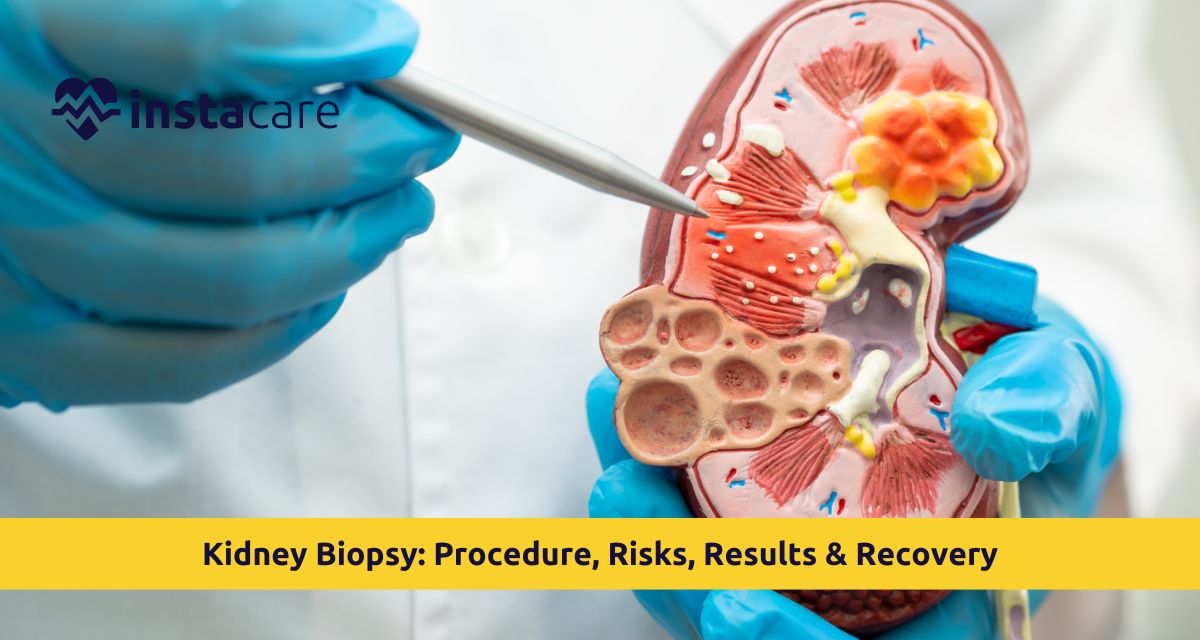Kidney function test or Kidney biopsy test is a critical diagnosis process for the extraction of a small amount of tissue from the kidney. The tissue is used to enable doctors to examine the microscopic structure of the kidney and also make a diagnosis of a variety of kidney diseases and conditions. It has proven beneficial in several instances in which the other tests, including blood and urine tests, will not provide adequate information about kidney function or damage.
Mysterious blood or Protein in urine biopsy, kidney infection, or diminishing kidney function usually needs to be accomplished by means of a biopsy. The test is fairly harmless but carries with there are some Risks of kidney biopsy that must be explained to patients. Understanding the entire Kidney biopsy procedure, why, how, what to anticipate in the future, to interpreting results, assists patients in preparing and taking care of their own kidney health.
What is a Kidney Biopsy?
Kidney biopsy or renal biopsy is an innocent procedure whereby a needle is inserted inside the kidney to collect some tissue samples. "Renal" is the medical term used to refer to kidneys. The biopsy allows pathologists to study the tissue under the microscope, which provides valuable information regarding the kidney's function that cannot be achieved by any other type of test.
Purpose of Kidney Biopsy
- To determine the absolute etiology of renal disease and assess the extent and severity of renal disease.
- To guide treatment based on the disease.
- To follow progression of renal disease.
- To detect rejection or disease in transplant patients with kidney.
Types of Kidney Biopsy
Percutaneous Kidney Biopsy
- Percutaneous kidney biopsy is the most frequent and least painful kind. Slim needle using CT scanning or ultrasonic guidance through the skin into the kidney.
- Open Kidney Biopsy: A technique in which cut is given to create an opening to gain access into the kidney, in case of needle biopsy being risky or unsafe.
- Transjugular Kidney Biopsy: By placing a catheter through the jugular vein, usually in patients with a bleeding risk.
Why a Kidney Biopsy is Done?
Indications for Renal Biopsy
Kidney biopsy is prescribed by physicians whenever they need a precise diagnosis which can't be achieved through blood and urine analysis. Some of the reasons are:
- Unexplained Hematuria: Excess or recurrent Blood in urine kidney biopsy without any identifiable cause.
- Proteinuria: Eliminating excess protein through urine, perhaps due to renal injury.
- Decreased Kidney Function: Kidney function dropped suddenly or rapidly.
- Suspected Glomerulonephritis: Inflamed filtering units in kidneys referred to as glomeruli.
- Kidney Injury or Inflammation: To diagnose the cause of nephrotic syndrome or acute kidney injury.
- Monitoring of Transplant Function: To identify early rejection or infection after kidney transplantation.
Diagnosis of Complex Kidney Disease
Infrequently are the illnesses of the kidneys alike by clinical syndrome or laboratory result. Kidney disease diagnosis of infection, autoimmune disease, or other pathogenic agents in kidney tissue differs. The individualized information determines the correct treatment regimen.
How to Prepare for a Kidney Biopsy
Pre-Procedure Evaluation
- Take drug history and history of previous illnesses.
- Draw blood to check your ability to clot blood and the function of your kidneys.
- Ask about allergy especially to anesthetic or medium contrast.
- Alert you against consuming a specific drug especially thinners such as aspirin warfarin, or NSAIDs.
Day of Procedure
- Fasting: You will be instructed not to eat or consume anything to drink 6-8 hours prior to the biopsy.
- What to Wear: Loose, comfortable clothes that are easy to slip on and off and allow easy access to your lower back.
- Coordinate Transportation: Since you'll be sedated or require someone to monitor you closely afterwards, arrange with someone to take you home.
Kidney Biopsy Procedure
Step-by-Step Explanation
- Positioning: You will lie down on your side or stomach to expose your lower back where kidneys are located.
- Anesthesia: The physician shall give local anesthetic to numb the area so that you shall experience no pain.
- Imaging Guidance: The doctor employs the imaging guidance of real-time ultrasound or CT scan in an effort to locate exactly where on the kidney the biopsy needle would have to be inserted with no injury.
- Tissue Sampling: A narrow, extremely fine needle is inserted through the skin into the kidney to remove small samples of tissue. Two or three are usually removed.
- When the Needle is Removed: Pressure is applied to the area to stop bleeding, and the wound where the biopsy was removed is rinsed and bandaged.
- Monitoring: You will be watched for 4-6 hours for any immediate problem like bleeding or pain.
Duration of the Procedure
The biopsy itself will typically take 30 minutes to an hour from start to finish.
What to Expect After the Kidney Biopsy?
Immediate Post-Procedure Care
- You can feel sore or sore a bit at where the biopsy was inserted.
- Rest and reduce activity for 24-48 hours.
Look for
- Bleeding or clots in your urine that are more than usual.
- Swelling or discomfort in the biopsy area that is severe.
- Fever or chills, which is infection.
Recovery Timeline:
- Most people will recover within a week.
- Heavy lifting, high-impact sports, or collision sports must be avoided for at least one week.
- Follow-up visits should monitor your Kidney biopsy recovery and provide biopsy results.
Explanation of Kidney Biopsy Results
The difference between Normal vs. Abnormal Results
- Normal Results: Shows normal kidney tissue that is not damaged, scarred, or inflamed.
- Abnormal Results: May show:
- Kidney inflammation(e.g., glomerulonephritis).
- Chronic injury, scarring or fibrosis.
- Immunocomplex deposits.
- Transplant biopsies show evidence of rejection.
Follow-Up Based on Results
Your doctor or
nephrologist will interpret your Kidney biopsy results and suggest treatment or lifestyle modification according to diagnosis. Immunouspressive therapy, dietary modification, or follow-up will be indicated in a few patients according to diagnosis.
Conditions Diagnosed with Kidney Biopsy
- Glomerulonephritis: Glomerulonephritis diagnosis is the Inflammation of the immune system leading to filters in kidneys.
- Nephrotic Syndrome: Proteinuria and edema increased.
- Acute or Chronic Kidney Injury: To diagnose etiology and severity.
- Kidney Transplant Rejection: Diagnosis of rejection at an early stage by biopsy.
- Interstitial Nephritis: Inflammation of space between tubules in kidneys.
- Amyloidosis or Other Rare Diseases: Deposition of faulty proteins in kidneys and thus damage.
Kidney Biopsy vs Renal Biopsy
Kidney and renal biopsy are interchangeable. "Renal" as a medical term is interchangeable with "kidney," and the two may be used for each other. Both the terms may seem to appear every now and then in the medical literature, but the Indications for kidney biopsy and procedure are the same.
Price of Kidney Biopsy in Pakistan
The fee varies from hospital to hospital, city to city, and on insurance but generally in the range of PKR 20,000 to PKR 50,000. Greater in private hospitals, subsidised in government hospitals. Ensure the charge and covers are disclosed prior to booking.
Book lab tests from the
best-certified labs in Lahore, Karachi, Islamabad, and all major cities of Pakistan through
InstaCare, and get a discount of up to 35%. For assistance, call our helpline at 03171777509 to find the right lab test for your health needs.

